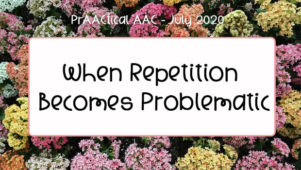PrAActical AAC Thoughts About Challenging Behavior

 Some PrAACtical AAC thoughts about challenging behavior: I wonder if it is ok to say that we love seeing challenging behavior during speech-language therapy sessions or observations. Well, I said it, both of us do, because if we really ‘listen’ then we can figure out what to teach that will really help our students. We tend to prioritize our goals into High Priority and General Priority. Challenging behavior and the communication message behind it, definitely falls into high priority. This is because challenging behavior in students limits experiences, limits interaction, and overall limits opportunities for people to get to know you.
Some PrAACtical AAC thoughts about challenging behavior: I wonder if it is ok to say that we love seeing challenging behavior during speech-language therapy sessions or observations. Well, I said it, both of us do, because if we really ‘listen’ then we can figure out what to teach that will really help our students. We tend to prioritize our goals into High Priority and General Priority. Challenging behavior and the communication message behind it, definitely falls into high priority. This is because challenging behavior in students limits experiences, limits interaction, and overall limits opportunities for people to get to know you.
Consider Challenging Behavior through Communication Glasses
- Is it really Challenging Behavior? behavior that is or can be destructive or hurtful. Examples include but are not limited to: hitting, biting, spitting, throwing, pounding, etc. (Note: we are not talking about poor eye contact or poor attention to task or even laughing to much. These may be challenging to teach or eliminate but they are not true challenging behavior)
- What is the Best Strategy to help with Challenging Behavior? PREVENTION. Let’s say it again- The best strategy for challenging behavior is PREVENTION. There is no better way to talk about it. We can prevent challenging behavior about 80% of the time (ok, I estimated that percentage but I am sure it is at least 80%
- What are the PREVENTION strategies we should consider?
- Visual Choice Making- was the student given choices where possible (which chair to sit in, which book to read, what art project to do?, if a teenager- choice to attend therapy or not?). Sometimes there really is not choice, but think about how many times there really is. A typical language user can negotiate their way into or out of a lot of situations. Without those negotiation skills, our students often have to do what we say when we say it. We need to use AAC strategies to help them negotiate their choices similarly to the student/child who asks several times, in several different ways so that the adult finally changes their minds.
- Visual Schedules- did the student know what to expect (within the session?, within the activity?)
- Visual Expectation Supports- did the student understand the expectations? (beyond the schedule- how many items need to be completed, what they needed to complete before moving on to a more preferred activity, what the consequences were for not following (consequence maps- if a particular challenging behavior occurs frequently)
- Break Cards– did the student have a way to say ‘I need a break’, and was it accepted- no questions asked?
- Visual Protesting Supports- did the student have a way to say no, really no, and #@$% no and was it accepted? If ‘no’ was not accepted, why? was it explained? Was there a visual way of telling when it might happen?
- Visual Venting Supports- did the student have supports to vent?, to say- I think this really stinks, don’t you?
- Self Calming Strategies & Activities- have you incorporated self-calming activities into the day? Are there opportunities for exercise and relaxing leisure activities (especially on stressful days?)
- Individualized Other Supports- are there specific supports the student needs to be successful (no one likes to fail…..)? Does the student know how to tell you he/she is not feeling well or sick?
- Make sure the student and others are safe.
- Decrease language input for a little while (that means stop or limit talking).
- Help guide the student through self-calming strategies.
- Follow through with the consequence map.
- Reduce demands for a little while (only 1 page of work instead of 2 etc).
- Learn from it by developing a visual support that might have prevented the challenging behavior.
- Check your prevention strategies- Were they USED?
- Consider using the Social Autopsy strategy by Rick Lavoie.
- Consider learning more about positive behavioral supports. Some resources are: ‘No More Meltdowns’ by Jed Baker or online modules from Florida State University- Positive Beginnings.
- Don’t talk about it to other people in front of the child.
- Don’t take it personally, once it is over make it really over. Use a pleasant voice, don’t bring up the past situation (yet).
- Don’t threaten for next time, or telling … (dad, mom, parents, teacher, etc…).
- Don’t implement the Social Autopsy strategy until everything has been calm for quite some time.
Filed under: PrAACtical Thinking
Tagged With: Challenging Behavior, communication, positive behavioral supports, visual supports
This post was written by Robin Parker





1 Comment
Thanks! This is really helpful. We also subscribe to the prevention method of behavior support — life is better when people don’t have to have a meltdown to communicate! I especially appreciated the reminder to use visual venting supports too — that’s something that I intend to fold into my practice next.